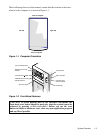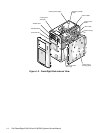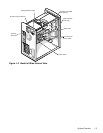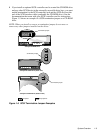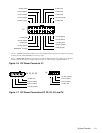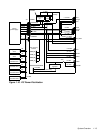
1-6 Dell PowerEdge 2100/180 and 2100/200 Systems Service Manual
System Memory
System memory has a minimum of 16 MB of 72-bit wide, buffered, EDO-type
memory. The system memory capacity can be expanded up to 256 MB by using
combinations of 16-, 32-, and 128-MB buffered, EDO-type dual in-line memory
modules (DIMMs).
The system board has four, 168-pin DIMM sockets. The DIMMs can be mixed.
The socket population rules are as follows:
•
Populate the DIMM sockets in order from DIMM_A (lower) to DIMM_D
(upper).
•
The DIMMs should be rated at 60 nanoseconds (ns) or faster. All of the sys-
tem memory operates at the speed of the slowest DIMM installed.
•
The largest capacity DIMM should be in socket DIMM_A with the smaller
capacity DIMMs installed in decreasing sizes toward socket DIMM_D.
The 72-bit wide, buffered, EDO DIMMs support the ECC feature that detects
memory errors and corrects single-bit memory errors. The ECC feature pro-
vides more reliable memory and less downtime. The ECC feature is built into
the memory controller on the system board.
See “DIMMs” in Chapter 4 for information on removing and replacing DIMMs.
Advanced Expansion Subsystem
The computer system offers advanced expansion subsystems that can support a
mixture of traditional EISA expansion cards, Plug and Play ISA expansion cards,
and PCI expansion cards. The EISA Configuration Utility included with the system
provides a means of avoiding resource conflicts that might arise from such an
arrangement.
After all legacy cards have been configured with the EISA Configuration Utility,
the system automatically assigns any required memory space, IRQ lines, and
DMA channels to any installed Plug and Play ISA expansion cards and PCI
expansion cards the next time the system is rebooted. Chapter 5, “Using the
EISA Configuration Utility,” in the User’s Guide describes the EISA Configura-
tion Utility and provides instructions for using it to configure the system.
The six expansion-card slots include three EISA expansion-card connectors and
three PCI expansion-card connectors. The expansion-card connectors are
located on the system board (see Figure 1-11).
Integrated Server Management
The system board contains integrated server management circuitry that moni-
tors whether the system cooling fan is running, as well as critical system
voltages and temperatures. The integrated server management circuitry works
in conjunction with the Intel LANDesk
®
Server Management suite.








